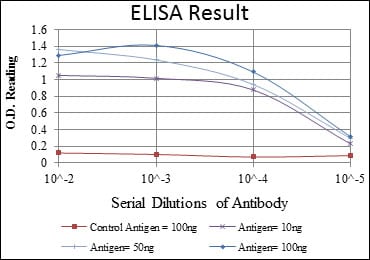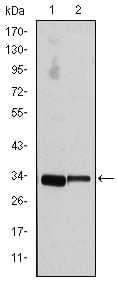

| WB | 咨询技术 | Human,Mouse,Rat |
| IF | 咨询技术 | Human,Mouse,Rat |
| IHC | 咨询技术 | Human,Mouse,Rat |
| ICC | 技术咨询 | Human,Mouse,Rat |
| FCM | 咨询技术 | Human,Mouse,Rat |
| Elisa | 1/10000 | Human,Mouse,Rat |
| Aliases | CCND3 |
| Entrez GeneID | 896 |
| clone | 6H4 |
| WB Predicted band size | 32kDa |
| Host/Isotype | Mouse IgG1 |
| Antibody Type | Primary antibody |
| Storage | Store at 4°C short term. Aliquot and store at -20°C long term. Avoid freeze/thaw cycles. |
| Species Reactivity | Human,Mouse |
| Immunogen | Purified recombinant fragment of human CCND3 expressed in E. Coli. |
| Formulation | Purified antibody in PBS with 0.05% sodium azide. |
+ +
以下是关于CCND3抗体的3篇参考文献的简要信息:
1. **文献名称**:*Cyclin D3 is a target gene of t(6;14)(p21.1;q32.3) translocation in B-cell malignancies*
**作者**:Sonnenschein H, et al.
**摘要**:该研究揭示了在B细胞淋巴瘤中,染色体易位t(6;14)导致CCND3基因的异常表达,并通过特异性抗体检测发现CCND3蛋白过表达与疾病进展相关,提示其作为潜在治疗靶点。
2. **文献名称**:*CCND3 overexpression enhances chemoresistance in colorectal cancer via β-catenin stabilization*
**作者**:Li Y, et al.
**摘要**:研究利用CCND3抗体分析结直肠癌组织,发现CCND3通过稳定β-catenin信号通路促进肿瘤细胞化疗耐药性,高表达患者预后较差,为靶向干预提供依据。
3. **文献名称**:*Cyclin D3 deficiency inhibits T-cell proliferation and leads to developmental defects in mice*
**作者**:Cooper CL, et al.
**摘要**:通过CCND3抗体在敲除小鼠模型中的研究,发现CCND3缺失导致T细胞增殖受阻和免疫发育异常,证实其在细胞周期调控中的关键作用。
以上文献均围绕CCND3抗体的应用展开,涵盖肿瘤机制、耐药性及免疫调控等领域。
CCND3 (Cyclin D3) is a member of the D-type cyclin family, which includes CCND1 and CCND2. These proteins play critical roles in regulating the cell cycle progression from the G1 to S phase by forming complexes with cyclin-dependent kinases (CDKs), particularly CDK4 and CDK6. The activated kinase complexes phosphorylate retinoblastoma (Rb) proteins, leading to the release of E2F transcription factors and subsequent initiation of DNA synthesis. CCND3 is encoded by the *CCND3* gene located on chromosome 6q21 and is expressed in various tissues, with higher levels observed in lymphoid cells and certain epithelial tissues.
Antibodies targeting CCND3 are essential tools for studying its expression, localization, and function in both physiological and pathological contexts. These antibodies are widely used in techniques such as Western blotting, immunohistochemistry (IHC), immunofluorescence (IF), and flow cytometry to detect CCND3 protein levels in cell lines, tissue samples, or experimental models. Specificity and validation (e.g., knockout cell lines or siRNA-mediated knockdown) are critical to ensure accurate detection, as cross-reactivity with other D-type cyclins can occur.
Dysregulation of CCND3 has been implicated in cancer. While CCND1 is more commonly associated with malignancies (e.g., mantle cell lymphoma via t(11;14) translocation), CCND3 overexpression or genetic alterations are linked to hematopoietic malignancies, including T-cell acute lymphoblastic leukemia (T-ALL) and multiple myeloma. Conversely, reduced CCND3 expression has been observed in some solid tumors. Research using CCND3 antibodies continues to explore its dual role as an oncogene or tumor suppressor, depending on cellular context, and its potential as a therapeutic target.
×